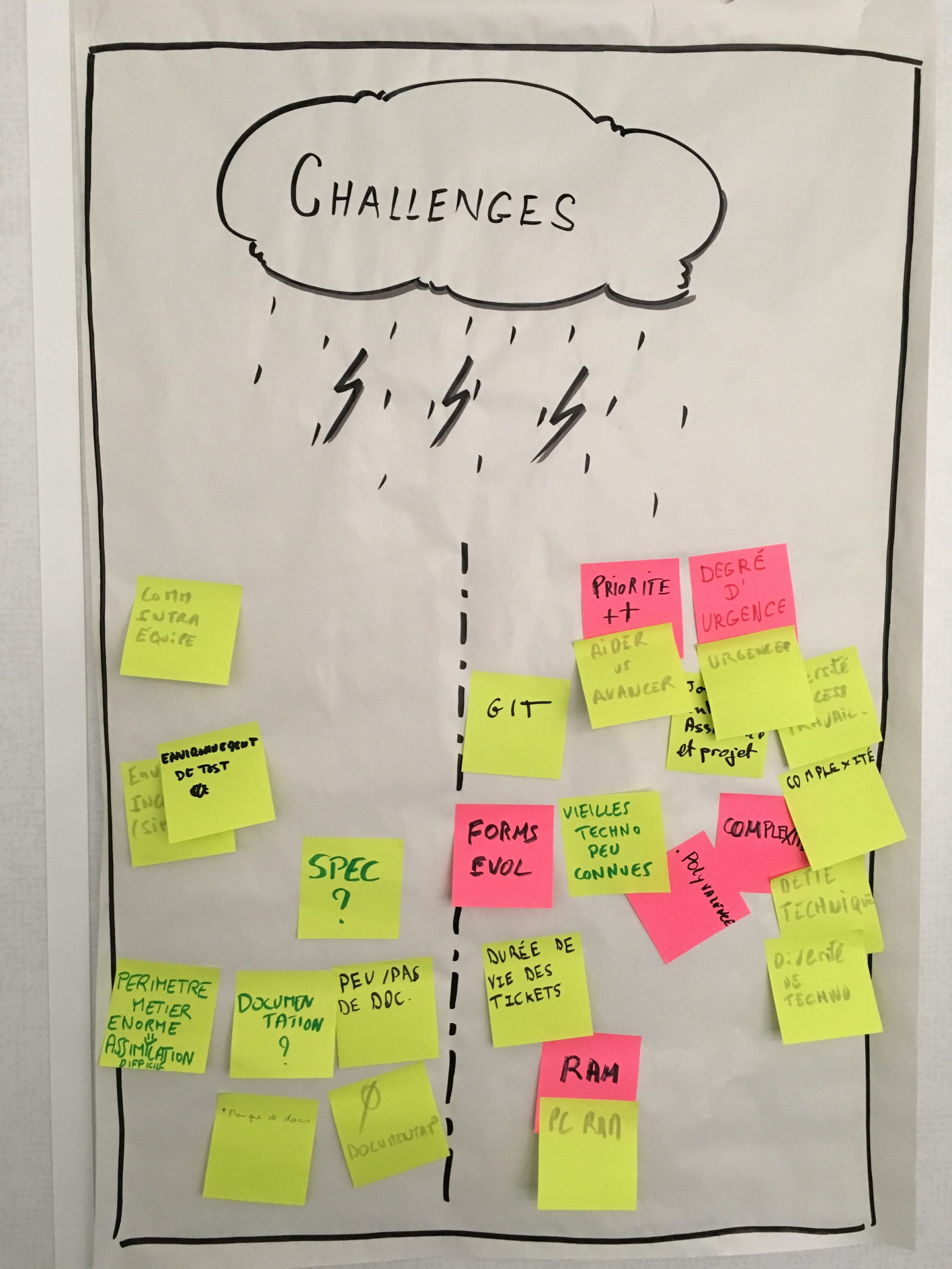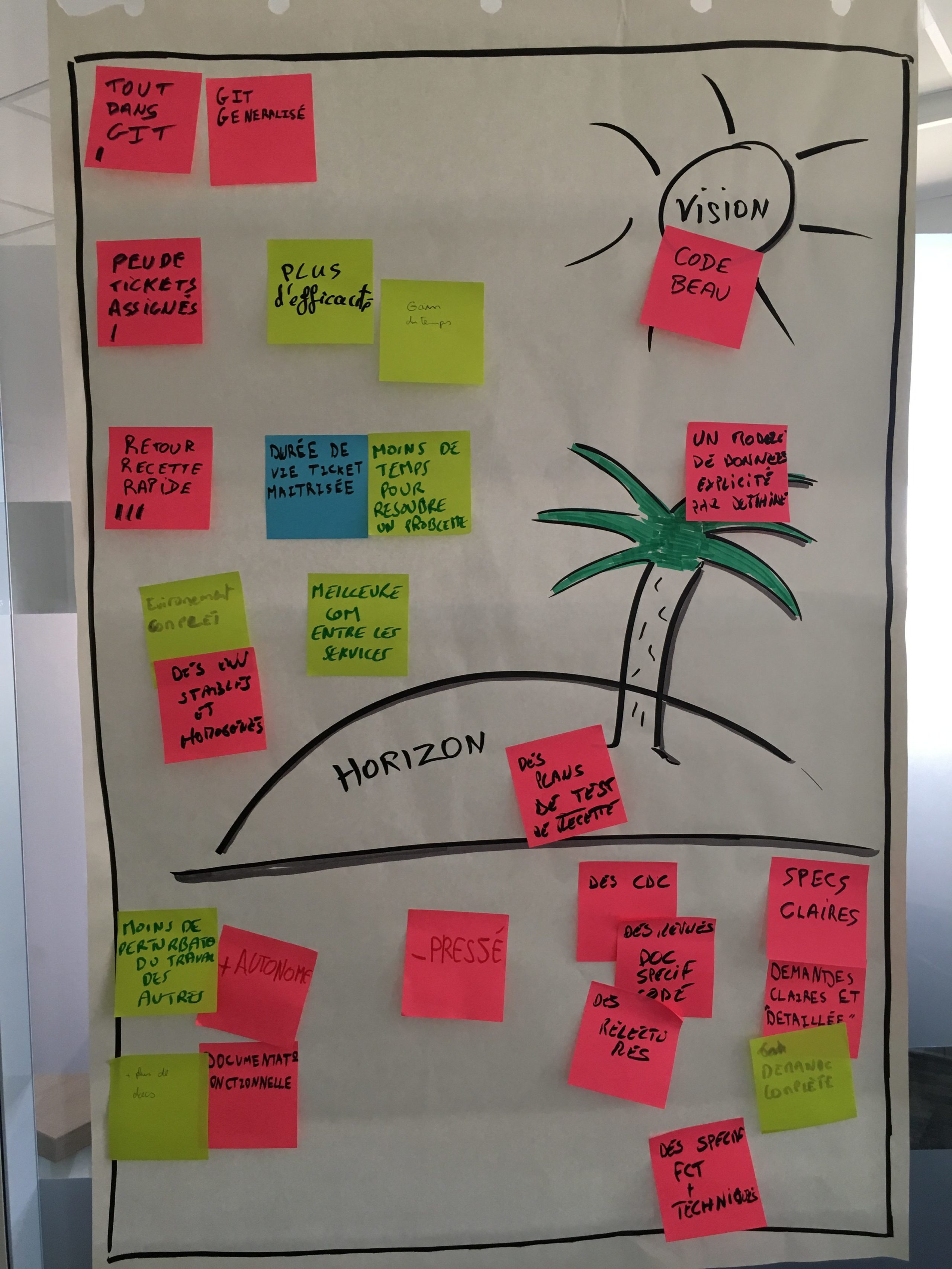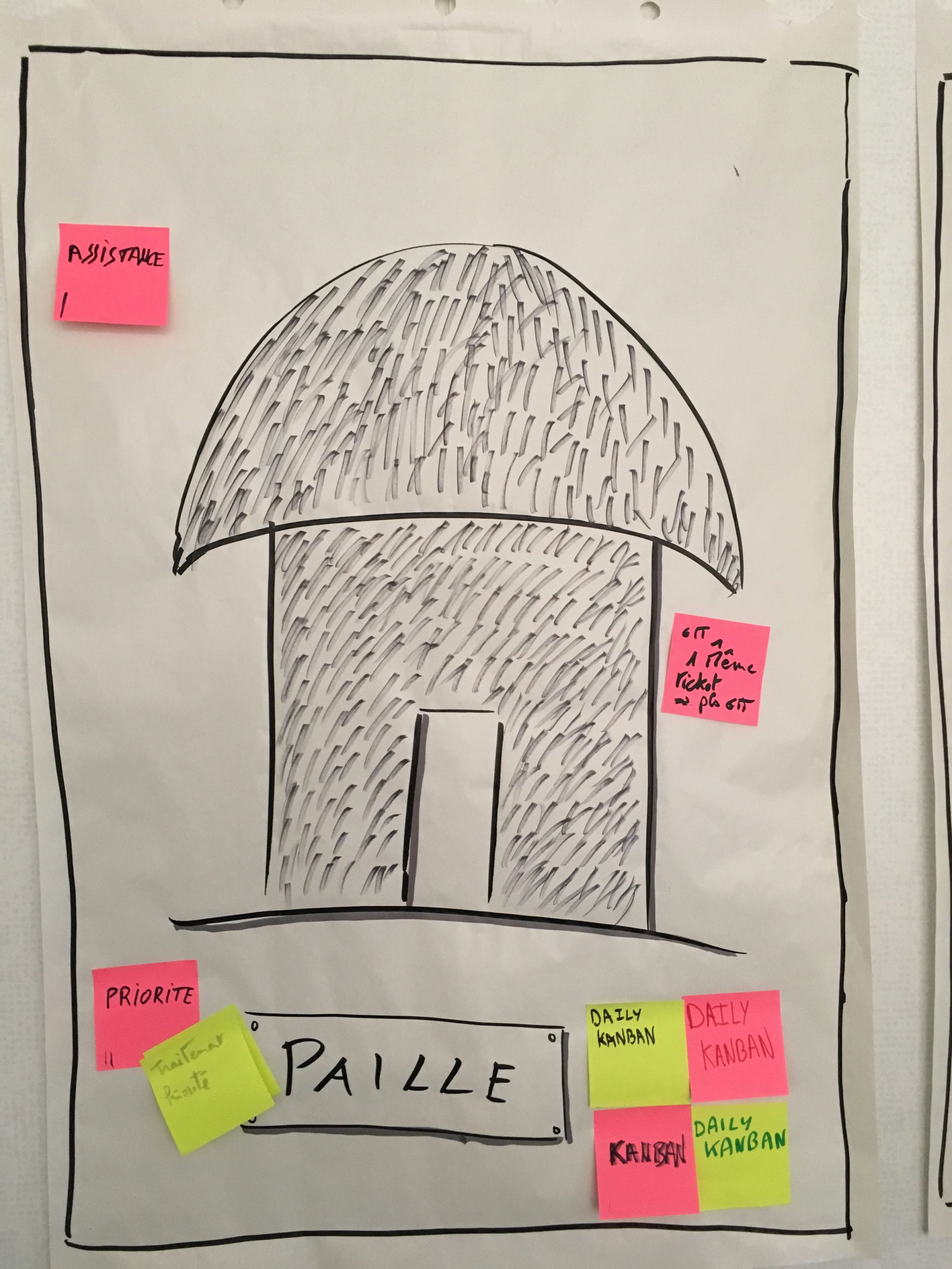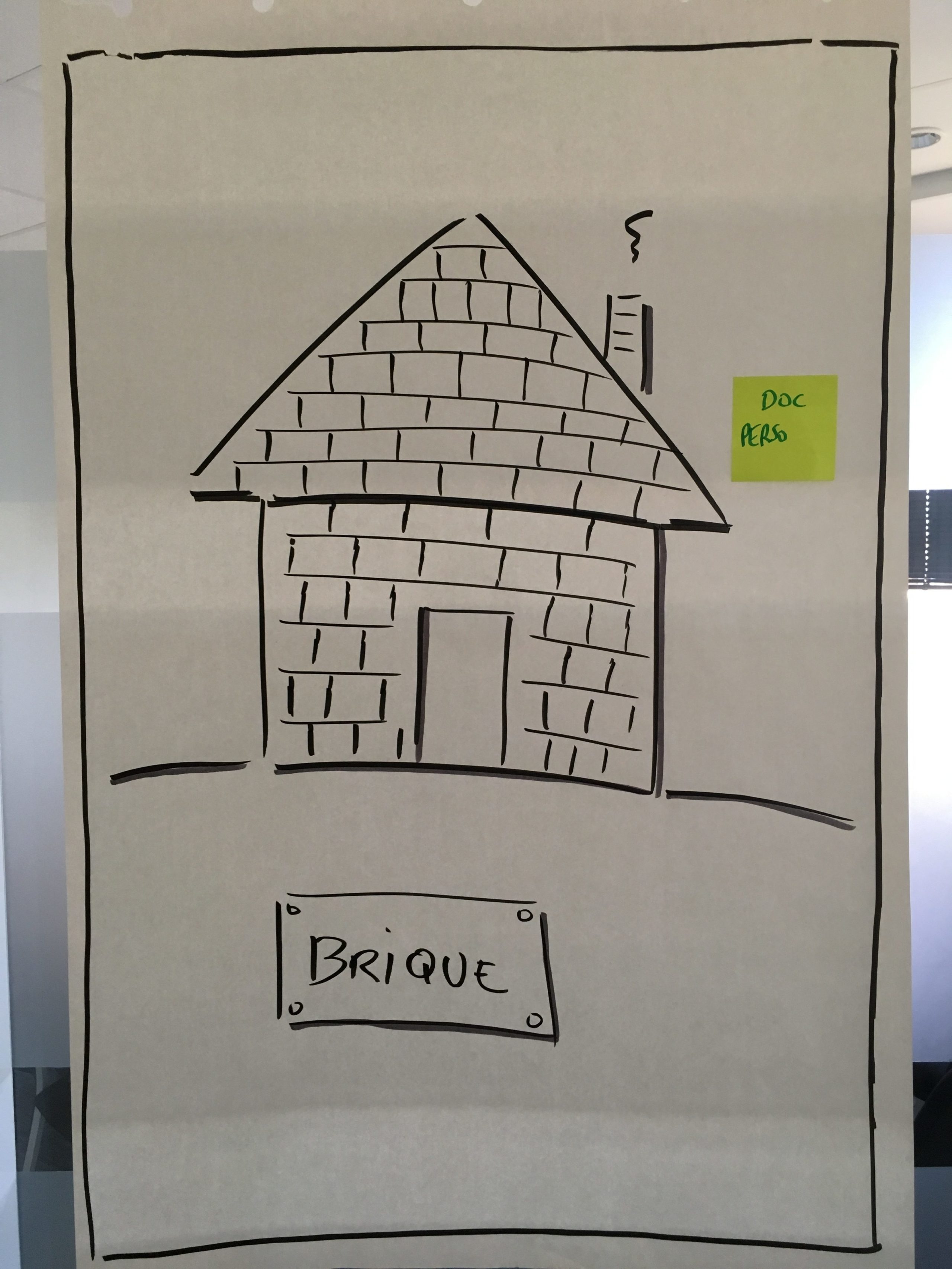J’accompagne actuellement un client dont une équipe utilise la méthode Kanban pour gérer son flux de maintenance. Ce choix est parti d’une présentation que j’avais effectuée aux managers de l’esprit de la démarche et de quelques pratiques à mettre en oeuvre pour démarrer.
Après quelques mois d’utilisation, on m’a demandé de faire le point avec l’équipe (que je n’avais pas eu l’occasion de rencontrer auparavant) afin de voir qu’elles étaient leurs impressions vis à vis de cette implémentation. Après réflexion sur l’atelier à leur proposer, j’ai décidé de partir sur une structure comprenant une rétrospective des 3 petits cochons que je vous présente ici.
Note : mes capacités de dessin étant particulièrement limitées, vous ne verrez malheureusement pas de cochons ni de loups ! 😛
Bonne lecture à vous ! 🙂
Déroulé
Comme vous pouvez le voir, j’ai décidé de ne pas uniquement me concentrer sur l’implémentation en cours mais de voir d’une manière plus globale à quoi ressemblait leur situation de travail :
- Challenges : pour comprendre d’où l’équipe vient et si elle en a conscience.
| Note : dans une version de la rétrospective des 3 petits cochons, j’avais vu cette partie représentée sous la forme du loup. |
- Vision : pour permettre à l’équipe d’exprimer sa voix et pour entrevoir des potentielles pistes d’amélioration.
- Rétrospective : pour faire l’état des lieux de la situation actuelle
- Débriefing : pour partager autour de l’atelier, redonner du sens aux pratiques en place aujourd’hui et qui ne seraient pas bien comprises et donner quelques perspectives.
Cela devrait me donner une bonne idée sur la pertinence de l’approche Kanban vis à vis des problématiques qui seront remontées par l’équipe ! 😉
Challenges

Dans cette partie, j’ai demandé à l’équipe de décrire les challenges auxquels ils ont dû faire face jusqu’à aujourd’hui et de les matérialiser sous forme de Post-it. Je leur ai précisé que ces problématiques pouvaient avoir été résolues mais je me suis dit que ce qui émergerait correspondrait plutôt à ce qui est toujours d’actualité de toute façon.
| Note 1 : j’avais initialement mis une ligne discontinue au milieu pour séparer les problématiques passées et résolues des problématiques actuelles. Il s’avère que cela n’a pas eu beaucoup d’utilité donc les Post-it ont été répartis de manière arbitraire par la suite. |
Sans surprises, on peut voir que le sujet qui est le plus souvent évoqué tourne autour de la priorisation continue, de la gestion des urgences et donc de l’organisation du travail. Je me dis alors que la démarche Kanban devrait être une bonne piste pour avancer sur cela.
Maintenant, à ma grande surprise, je me rends compte que des problématiques de documentation sont également très présentes : documentation au sens description du besoin (savoir ce que l’on veut faire) et documentation au sens description de la solution (comment cela fonctionne).
Vision / Horizon

Suite à l’évocation des challenges de l’équipe, place au futur désiré ! 🙂
Je propose à chacun de décrire sur des Post-it leur vision de leur environnement de travail idéal, de l’horizon à atteindre. La distinction vision / horizon peut apparaître subtile mais selon les personnes, le choix des mots peut avoir un impact différent. L’important pour moi était d’aider l’équipe à formuler des phrases du type :
Dans mon futur idéal, telle chose est vraie.
Après avoir explicité les challenges et le futur idéal, il était temps d’analyser la situation actuelle. C’est là que nos 3 petits cochons vont pouvoir jouer leur rôle !
Avant de commencer, je demande alors à chaque personne d’écrire à minima un post-it intitulé « Kanban » afin d’avoir leur ressenti sur cette implémentation. Je décris chaque maison (comme ci-après) et demande à chacun de traiter les 3 maisons en une fois par souci d’efficacité.
Maison de paille
Voici l’instruction donnée aux participants :
Que faites-vous aujourd’hui qui pourrait s’écrouler en un coup de vent ?
Résultat :

J’ai trouvé intéressant de voir quelques éléments liés à la priorité ici, ce qui est tout à fait cohérent avec la problématique actuelle de gestion du travail de l’équipe.
On retrouve plusieurs tickets « Kanban » dans cette catégorie, ce qui pourrait apparaître comme alarmant. Cependant, la précision faite par certaines personnes sur le Daily Kanban a permis de mettre en lumière que la problématique tournait surtout autour d’un manque d’organisation.
En effet, il s’avère que le Daily Kanban évoqué correspond à un Daily organisé autour d’un flux de maintenance qui concentre des personnes de plusieurs départements. La difficulté comparée à un Daily d’une même équipe est que la disponibilité des personnes est variable et que la présence de tout le monde n’est pas forcément requise à chaque fois.
La problématique qui m’apparaît alors intéressante à étudier n’est peut-être pas au niveau de l’animation du Daily Kanban (même si cela peut toujours aider) mais au niveau de la structure des équipes autour du traitement de ce flux de maintenance.
Maison de bois
Voici l’instruction donnée aux participants :
Que faites-vous aujourd’hui qui tient la route mais qui mériterait consolidation ?
Résultat :

Des Post-it Kanban apparaissent ici en nombre quasi-équivalent à la catégorie précédente ce qui est encourageant. En effet, la mécanique du Stop Starting, Start Finishing a porté ses fruits et a diminué le stock de ticket de quasiment 50% en l’espace de 2 mois ! 🙂
Il m’apparaît cependant important d’aller un peu plus loin dans la démarche en mettant en place des limites dans le flux lui-même également plutôt que de bloquer uniquement en entrée, même si cela était déjà un bon début !
Maison de brique
Voici l’instruction donnée aux participants :
Que faites-vous aujourd’hui qui est solide, fiable et dont vous êtes satisfaits ?
Résultat :

Sans grande surprise, la dernière catégorie n’a pas eu beaucoup de succès. Est-ce parce-que l’on peut toujours considérer que les choses sont perfectibles ou que l’on ne peut jamais être satisfait de ce que l’on a ? Je ne sais pas vraiment. Cependant, je pense que dans certaines équipes, cela peut permettre d’acter ensemble les choses qui fonctionnent bien et qui méritent de ne pas être oubliées.
Dans une rétrospective habituelle, on voudrait prioriser et sélectionner des sujets par la suite afin de mettre des actions en place. Vu que ce n’était pas l’objet de l’atelier, je ne l’ai pas fait ! 🙂
Conclusion

Je trouve ce format de rétrospective intéressant pour l’angle pris par la métaphore des différentes maisons que j’ai rarement retrouvé ailleurs. Cela marche finalement plutôt bien pour un état des lieux en classifiant les pratiques mises en oeuvre selon 3 axes.
Combiné avec un peu de solution focus, je pense que l’atelier a pu mettre en lumière les attentes, les objectifs ainsi que la situation actuelle de manière assez claire et naturelle.
Je vous invite à le tester (si ce n’est pas déjà fait) et à me dire ce que vous en pensez 🙂







